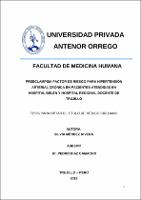Mostrar el registro sencillo del ítem
Preeclampsia factor de riesgo para hipertensión arterial crónica en pacientes atendidas en Hospital Belén y Hospital Regional Docente de Trujillo
| dc.contributor.advisor | Díaz Camacho, Pedro | |
| dc.contributor.author | Méndez Rivera, Silvia | |
| dc.creator | Méndez Rivera, Silvia | |
| dc.date.accessioned | 2018-05-03T19:47:29Z | |
| dc.date.available | 2018-05-03T19:47:29Z | |
| dc.date.issued | 2018 | |
| dc.identifier.uri | https://hdl.handle.net/20.500.12759/4094 | |
| dc.description.abstract | OBJETIVO: Determinar si la pre eclampsia es factor de riesgo para hipertensión arterial crónica. MATERIAL Y MÉTODO: Se realizó un estudio observacional, analítico de casos y controles, en el Hospital Belén de Trujillo y Hospital Regional Docente durante el periodo comprendido entre enero 2015 a diciembre 2017, que evaluó a 300 mujeres de 35 a 50 años de edad que se atendieron en el Hospital Belén de Trujillo y Hospital Regional Docente. El análisis estadístico utilizado fue la prueba chi-cuadrado para variables cualitativas y la t de student para variables cuantitativas. RESULTADOS: El análisis bivariado de las características generales del estudio mostró que las variables con mayor significancia (p < 0,05) fueron la edad (44,18 ± 4,80 y 41,59 ± 5,24 años), el IMC (28,85 ± 3,23 y 27,71 ± 2,50 Kg/m2) y la presencia de gran multiparidad (28% y 14,50%; ORc = 2,29 [1,27-4,13]). El IMC categorizado mantuvo su significancia estadística. El antecedente de preeclampsia en cada uno de los grupos (19% y 6,50%; p < 0,01; ORc = 3,37 [1,59-7,16]); el tipo de parto por cesárea (55% y 24%; p < 0,01; ORc = 3,87 [2,32-6,45]) y la edad gestacional al momento del parto (37,83 ± 1,58 y 38,58 ± 1,27 semanas; p < 0,01) resultaron ser significativas también. CONCLUSIONES: El antecedente de preeclampsia resultó ser un factor de riesgo para la presencia de hipertensión arterial. | es_PE |
| dc.description.abstract | OBJECTIVE: To determine if preeclampsia is a risk factor for chronic arterial hypertension. MATERIAL AND METHODS: An observational, analytical study of cases and controls was carried out at the Hospital Belen y Hospital Regional Docente de Trujillo during the period from January 2015 to December 2017, which evaluated 300 women between 35 and 50 years of age who attended. The statistical analysis used was the chi-square test for qualitative variables and the student's t for quantitative variables. RESULTS: The bivariate analysis of the general characteristics of the study showed that the variables with the greatest significance (p <0.05) were age (44.18 ± 4.80 and 41.59 ± 5.24 years), BMI (28, 85 ± 3.23 and 27.71 ± 2.50 Kg / m2) and the presence of large multiparity (28% and 14.50%; ORc = 2.29 [1.27-4.13]). The categorized BMI maintained its statistical significance. The history of preeclampsia in each of the groups (19% and 6.50%, p <0.01, ORc = 3.37 [1.59-7.16]); the type of cesarean delivery (55% and 24%; p <0.01; ORc = 3.87 [2.42-6.45]) and gestational age at delivery (37.83 ± 1.58) and 38.58 ± 1.27 weeks, p <0.01) were also found to be significant. CONCLUSIONS: The history of preeclampsia turned out to be a risk factor for the presence of hypertension. | en_US |
| dc.description.uri | Tesis | es_PE |
| dc.format | application/pdf | es_PE |
| dc.language.iso | spa | es_PE |
| dc.publisher | Universidad Privada Antenor Orrego | es_PE |
| dc.relation.ispartofseries | T_MED.HUMA_2388 | |
| dc.rights | info:eu-repo/semantics/openAccess | es_PE |
| dc.rights.uri | https://creativecommons.org/licenses/by/4.0/ | es_PE |
| dc.source | Universidad Privada Antenor Orrego | es_PE |
| dc.source | Repositorio Institucional - UPAO | es_PE |
| dc.subject | Preeclampsia | es_PE |
| dc.subject | Hipertensión arterial | es_PE |
| dc.subject | Factor de riesgo | es_PE |
| dc.title | Preeclampsia factor de riesgo para hipertensión arterial crónica en pacientes atendidas en Hospital Belén y Hospital Regional Docente de Trujillo | es_PE |
| dc.type | info:eu-repo/semantics/bachelorThesis | es_PE |
| thesis.degree.level | Título Profesional | es_PE |
| thesis.degree.grantor | Universidad Privada Antenor Orrego. Facultad de Medicina Humana | es_PE |
| thesis.degree.name | Médico Cirujano | es_PE |
| thesis.degree.discipline | Medicina Humana | es_PE |
| dc.subject.ocde | https://purl.org/pe-repo/ocde/ford#3.02.27 | es_PE |
| renati.type | https://purl.org/pe-repo/renati/type#tesis | es_PE |
| renati.level | https://purl.org/pe-repo/renati/level#tituloProfesional | es_PE |
| renati.discipline | 912016 | es_PE |
| dc.publisher.country | PE | es_PE |
Ficheros en el ítem
Este ítem aparece en la(s) siguiente(s) colección(es)
-
Medicina Humana [2814]


